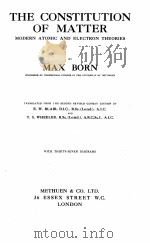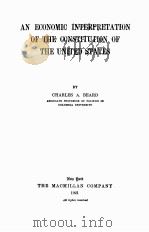《THE CONSTITUTION OF GLASSES A DYNAMIC INTERPRETATION VOLUME 1》
| 作者 | 编者 |
|---|---|
| 出版 | INTERSCIENCE PUBLISHERS |
| 参考页数 | 427 |
| 出版时间 | 1962(求助前请核对) 目录预览 |
| ISBN号 | 无 — 求助条款 |
| PDF编号 | 812498518(仅供预览,未存储实际文件) |
| 求助格式 | 扫描PDF(若分多册发行,每次仅能受理1册) |

Ⅰ.Structural Principles of Condensed Systems,1
1.Nature of Chemical Binding Forces,2
2.Origin of the Solid State,6
3.Types of Screening of Positive Cores,9
A.Noble Gases,10
B.Metals,10
C.Formation of Molecules with Molecular Orbitals,10
D.Formation of Cations and Anions,11
E.Screening of the Proton,11
Ⅱ.Properties of Cations and Anions,14
1.Electronic Structures of Ions,16
2.Sizes of Ions,22
3.Charges of Ions,26
4.Polarization Properties of Ions,31
Ⅲ.Mutual Interaction of Ions,35
1.K.Fajans’Rules,39
2.Effect of Temperature and Pressure,43
Ⅳ.Disproportionation of the Binding Forces,47
Ⅴ.Chemical Aspects of the State of Polarization of Ions,51
1.Acidity-Basicity Concept in Condensed Systems,52
A.Development of an Acidity-Basicity Concept Based upon the Nature of the Cation,56
B.Development of an Acidity-Basicity Concept Based upon the Nature of the Anion,59
C.Molar Refractivity of O2- Ions and the Acidity of Solids,61
2.Field Strengths of Cations and Compound Formation in Oxide Systems: Dietzel’s Rules,64
3.Change of Chemical Properties of Cations through One-sided Polarization in Surfaces,67
4.Atomistic Approach to the Rates of Chemical Reactions,69
A.Conventional Descriptions of Rate Phenomena,69
B.Partial Temporary Unscreening of Cations as an Energy Barrier in Chemical Reactions,74
C.State of Polarization of Anions as Rate-Determining Factor in Hydrolysis,81
Ⅵ.Ideal Crystals,94
1.Pauling’s Rules,96
2.Isostructural Crystals and Solid Solutions,98
3.Polymorphism,100
4.Goldschmidt’s Model Substances,101
Ⅶ.Real Crystals,104
1.Effect of the Entropy upon the Stability of a Defective Crystal,105
2.Types of Defects,108
A.Frenkel Defects,109
B.Schottky Defects,110
C.Berthollide-Compounds,111
3.Semiconductors,111
Ⅷ.Amorphous Solids,118
1.Energy Profile Scheme,119
2.Amorphous Solids from Vapors,121
3.Amorphous Solids from Crystals,122
A.Metamict Minerals,122
B.Mechanical Amorphization,124
4.Amorphous Solids from Melts,125
Ⅸ.Structure of Liquids,128
1.Problems of the Liquid State,129
2.Concept of Liquid Structures,132
A.Bernal Model,132
B.Frenkel Model,133
C.Stewart Model,134
3.Description of the Real Structure of a Liquid on the Basis of Three Idealized Extreme Models,139
4.Structure of Water and Some of Its Manifestations,144
5.Inorganic Compounds as Solvents,156
A.Anhydrous Hydrofluoric Acid,158
B.Liquid Ammonia,160
C.Liquid Water,163
D.Water Vapor,168
Ⅹ.Melting of Crystals,171
1.Fundamental Aspects of the Melting of Ionic Compounds,172
2.Factors Determining the Melting Points of Simple Com-pounds,174
A.Charge,175
B.Anion to Cation Ratio,175
C.Size of the Cation,176
D.Polarizability of the Ions,177
3.Anomalous Behavior of Compounds of Hydrogen, Lithium,Beryllium, and Boron,178
4.Structural Changes during Melting,180
Ⅺ.Nucleation and Crystallization,182
1.Equilibria versus Rate Processes,182
2.Theoretical Approaches to Nucleation,187
3.Nucleation of Gas Bubbles from Supersaturated Liquids,191
4.Nucleation and Crystallization of Supercooled Liquids,196
5.Atomistic Approach to Nucleation,199
Ⅻ.Compatibility in Glass-Forming Systems,203
1.Equilibrium Aspects of Compatibility,203
2.Kinetic Aspects of Compatibility,214
A.Suppression of the Volatility of Compounds,214
B.Corrosion of Refractory Materials,216
ⅩⅢ.Conditions of Glass Formation,219
1.Critical Review of Earlier Approaches to Glass Formation,219
A.Shape of Molecules,219
B.Nature of the Chemical Bond,222
C.Bond Strength,227
D.Crystal Structure Approach,230
2.Dynamic Approach to Glass Formation,238
A.Rate of Cooling,240
B.Liquidus Temperature,241
C.Nucleation Rate,242
D.Heterogeneity of Complex Glasses,243
E.Conclusions,246
ⅩⅣ.Historical Review of Concepts Concerning the Nature of the Glassy State,249
1.Some Early Views on the Constitution of Glasses,249
2.Classical Work on the Vitreous State (Contributions of G.Tammann and His School),253
3.Modern Approach to Glasses on the Basis of Crystal Chem-istry (Contributions of V.M.Goldschmidt and His School),259
4.Application of X-ray Diffraction Methods to Glass (Con-tributions of B.E.Warren and His School),261
ⅩⅤ.Some Problems Concerning the Constitution of Glasses,265
1.Similarity of Unrelated Substances in the Glassy State in the Transformation Region,265
2.Effect of the Thermal History of Glasses on Their Properties,266
3.Boric Acid Anomaly,266
4.Mixed Alkali Effects,268
5.Interdependence of Physical and Chemical Properties,268
6.Properties of Glasses and Phase Relationships,269
ⅩⅥ.Useful Experimental Methods for Studying the Constitu-tion of Glasses,271
1.X-ray Diffraction Method,273
2.Infrared Spectra,280
3.Color and Fluorescence Indicators,290
A.Introductory Remarks,290
B.A Classification of Color and Fluorescence Centers and Their Uses as Indicators in Structural Problems of Glasses,291
C.Conclusions,327
4.Magnetism,329
5.Refractive Index, Molar Refractivity, and Density,331
6.Specific Heat,343
7.Thermal Conductivity,348
8.Thermal Expansivity,353
9.Compressibility,362
10.Hardness,371
11.Electrical Potentials,386
A.Development of the Oxygen Electrode Using Glass as the Electrolyte,386
B.Fundamentals Concerning the Establishment of Elec-trical Potentials,389
C.Temperature Gradient as a Source of an Electrical Po-tential,392
D.Oxidation-Reduction Phenomena as Sources of Elec-trical Potentials,393
E.Acid-Base Reactions as Sources of Electrical Potentials,394
F.Summary,403
12.Review of the Major Contributions of the Different Methods to the Constitution of Glasses,404
References,408
Name Index,419
Subject Index,425
1962《THE CONSTITUTION OF GLASSES A DYNAMIC INTERPRETATION VOLUME 1》由于是年代较久的资料都绝版了,几乎不可能购买到实物。如果大家为了学习确实需要,可向博主求助其电子版PDF文件(由 1962 INTERSCIENCE PUBLISHERS 出版的版本) 。对合法合规的求助,我会当即受理并将下载地址发送给你。
高度相关资料
-

- THE CONSTITUTION OF INDIA ANALYSIS AND INTERPRETATION
- 1982 ALLAHABAD LAW AGENCY
-

- THE LANGUAGE OF INTERPRETATION
- 1995 NATIONAL COUNCIL OF TEACHERS OF ENGLISH
-

- THE INTERPRETATION OF DREAMS VOLUME 4
- 1976 PENGUIN BOOKS
-

- THE LIMITS OF INTERPRETATION
- 1990 INDIANA UNIVERSITY PRESS
-

- TO RUN A CONSTITUTION THE LEGITIMACY OF THE ADMINISTRATIVE STATE
- 1986 UNIVERSITY PRESS OF KANSAS
-

- THE ENDURING CONSTITUTION A BICENTENNIAL PERSPECTIVE
- 1987 WEST PUBLISHING COMPANY
-

- A MATTER OF INTERPRETATION FEDERAL COURTS AND THE LAW
- 1997 PRINCETON UNIVERSITY PRESS
-

- THE ANCESTRAL CONSTITUTION VOLUME 25
- 1953 ROUTLEDGE
-

- HERITAGE INTERPRETATION VOLUME 1
- 1989 BELHAVEN PRESS
-

- POLYPROPYLENE
- 1968 GORDON AND BREACH SCIENCE PUBLISHERS
-

- THE CURRENT INTERPRETATION OF WAVE MECHANICS A CRITICAL STUDY
- 1964 ELSEVIER PUBLISHING COMPANY
-

- THE CONSTITUTION OF MATTER
- 1923 METHUEN AND CO. LTD.
-

- AN ECONOMIC INTERPRETATION OF THE CONSTITUTION OF THE UNITED STATES
- 1921 THE MACMILLAN COMPANY
提示:百度云已更名为百度网盘(百度盘),天翼云盘、微盘下载地址……暂未提供。➥ PDF文字可复制化或转WORD

